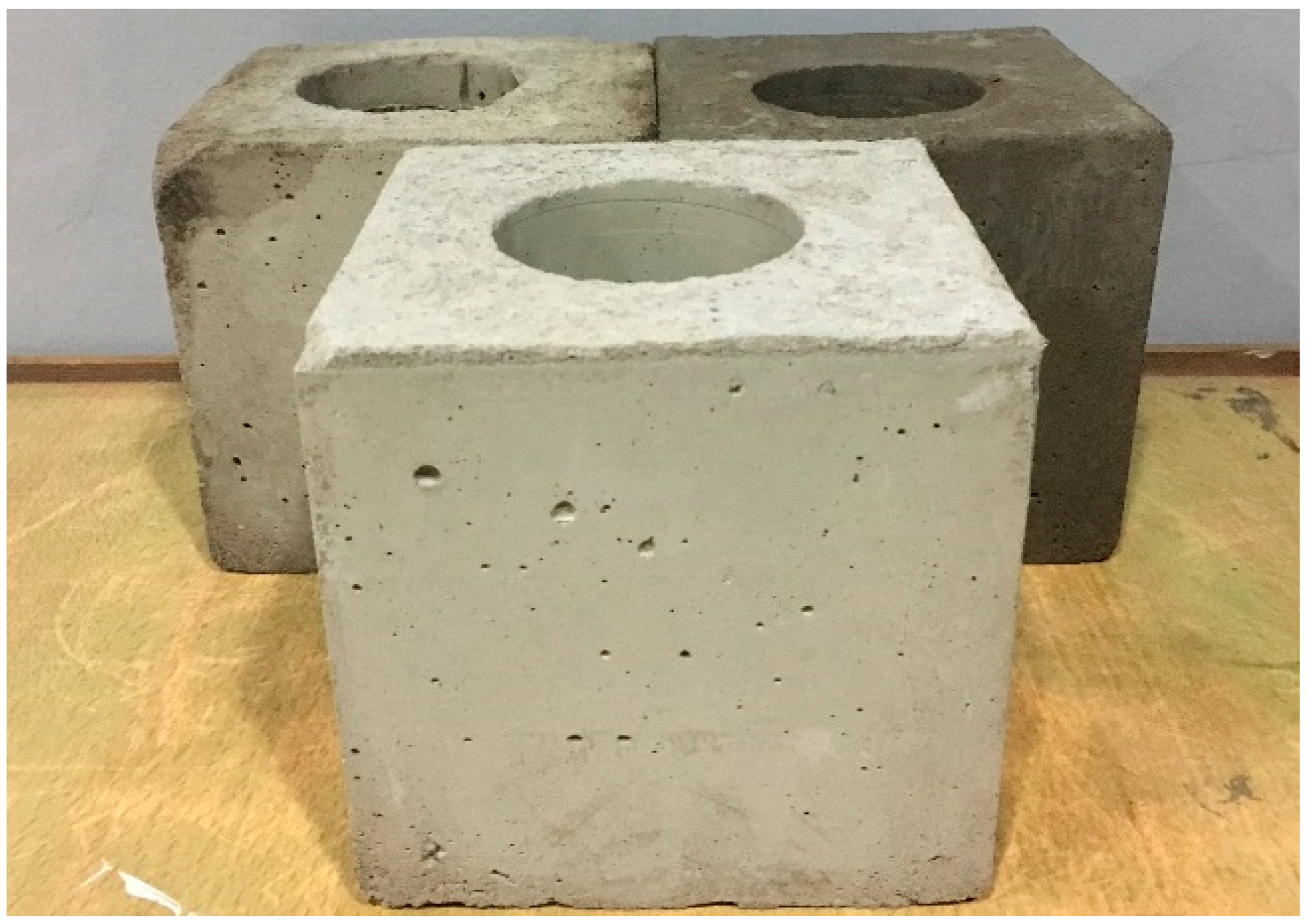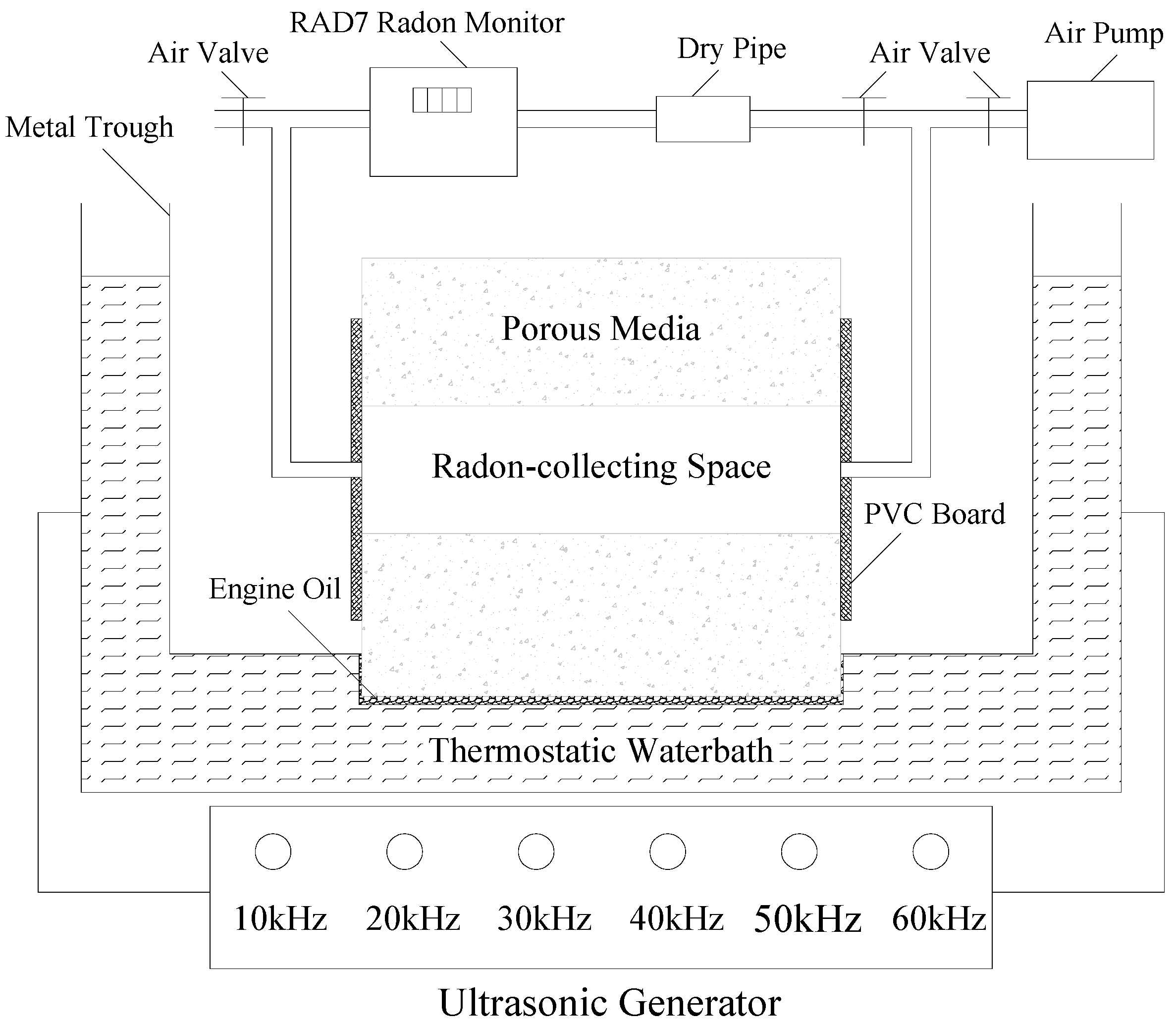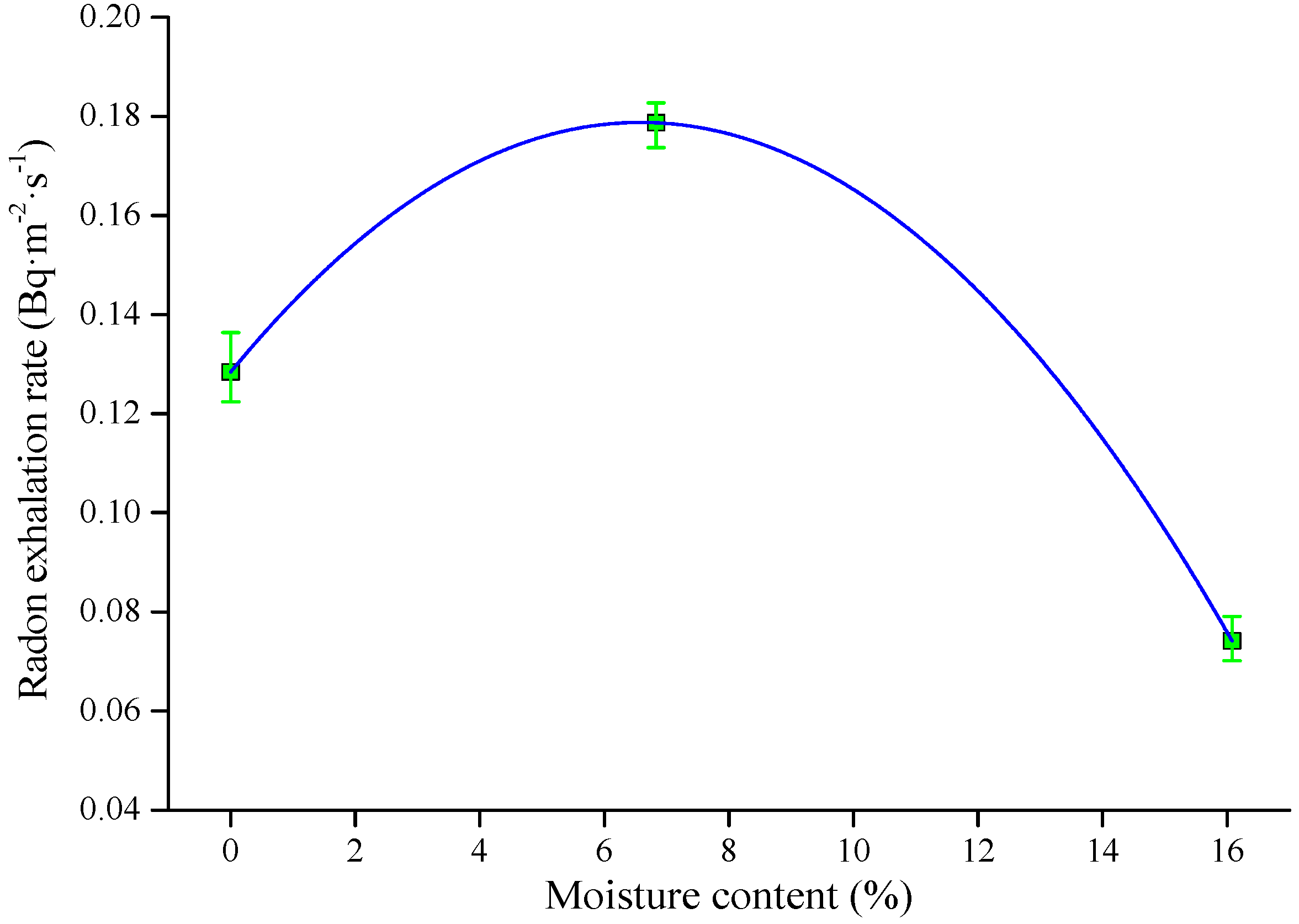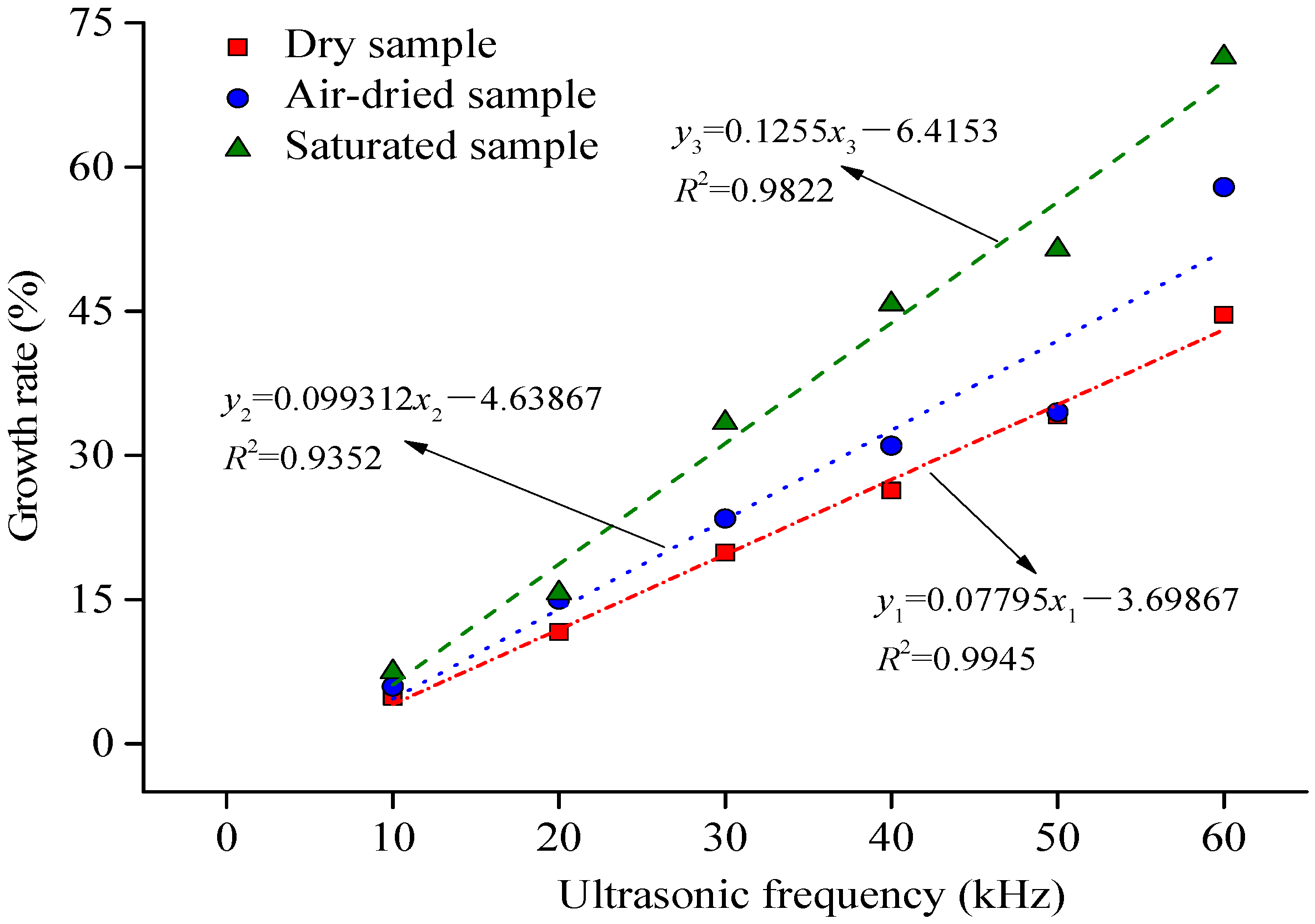Effect of Ultrasonic Treatment on Radon Exhalation from Porous Media: An Experimental Case Study
Abstract
:1. Introduction
2. Material and Methods
2.1. Sample Preparation and Basic Properties Determination
2.2. Measurement of Radon Exhalation Rate under Ultrasonic Treatment
2.2.1. Description of Experimental Apparatus
2.2.2. Experimental Procedure
- (1)
- Check the gas-tightness of the apparatus, and never begin an experiment until the tightness meets requirement.
- (2)
- Place the flume inlayed with the prepared sample in the thermostatic water bath in preparation for ultrasonic treatment.
- (3)
- Each experiment was divided into three experimental units (30 min per experimental unit), namely, the pre-ultrasonic treatment (Pre-UT) unit, under ultrasonic treatment (Under-UT) unit, and post-ultrasonic treatment (Post-UT) unit. Continually monitor the radon concentration of each experimental unit, for which the monitoring data were denoted as A1, A2, and A3.
- (4)
- After completing the experiments, switch off all the devices and seal up the samples for 24 h for next experiments.
3. Results and Discussion
3.1. Radon Exhalation Characteristics for Pre-UT Unit
3.2. Radon Exhalation Characteristics for Under-UT Unit and Post-UT Unit
4. Conclusions
- (1)
- The radon exhalation rate of porous media to some extent increased under the treatment of ultrasonic action, and a positive correlation was discovered between the growth rate of the radon exhalation rate and ultrasonic frequency.
- (2)
- The radon exhalation rate of porous media slightly decreased after ceasing ultrasonic treatment, however, it would increase to the initial value when the sample was sealed for 24 h. That is to say, the radon exhalation capacity was insignificantly affected by ultrasonic action.
- (3)
- The radon exhalation rate of the air-dried sample was greater than those of the dry and saturated samples, and the water-saturated sample exhibited the lowest radon exhalation rate. The exhaling of radon from porous media was greatly affected by its moisture content.
- (4)
- The porous media with increased moisture content favored the conduction of ultrasonic waves; that is, the growing effect of ultrasonic treatment on the radon exhalation rate of the water-saturated sample was relatively prominent.
- (5)
- The variant feedback mechanisms of ultrasonic treatment on radon exhaling from those porous media with different moisture contents were found in this study as well as in the field of radon monitoring in different regions (the regions with various hydrogeological conditions). Therefore, the strengthening of radon monitoring in different regions could provide useful references for earthquake prediction. Nevertheless, considering that the proposed experimental model in this study was simplified, further insights are therefore required for a reliable correlation with the real monitoring of radon concentrations in a seismically active belt.
Author Contributions
Funding
Acknowledgments
Conflicts of Interest
References
- Friedmann, H. Radon in earthquake prediction research. Radiat. Prot. Dosim. 2012, 149, 177–184. [Google Scholar] [CrossRef] [PubMed]
- Ulomov, V.I.; Mavashev, B.Z. A precursor of a strong tectonic earthquake. Dokl. Akad. Sci. USSR Earth Sci. Sect. 1967, 176, 9–11. [Google Scholar]
- King, C.Y. Impulsive radon emanation on a creeping segment of the San Andreas fault, California. Pure Appl. Geophys. 1984, 122, 340–352. [Google Scholar] [CrossRef]
- Virk, H.S.; Singh, B. Radon anomalies in soil-gas and groundwater as earthquake precursor phenomena. Tectonophysics 1993, 227, 215–224. [Google Scholar] [CrossRef]
- Walia, V.; Virk, H.S.; Bajwa, B.S.; Sharma, N. Relationships between radon anomalies and seismic parameters in N-W Himalaya, India. Radiat. Meas. 2003, 36, 393–396. [Google Scholar] [CrossRef]
- Ghosh, D.; Deb, A.; Sengupta, R. Anomalous radon emission as precursor of earthquake. J. Appl. Geophys. 2009, 69, 67–81. [Google Scholar] [CrossRef]
- Zhang, S.M.; Shu, Y.L.; Wang, X.; Lin, J.Z.; Peng, Y.Z. Primary research on relationship between gas radon in Zhouzhi well and earthquake in neighboring regions. J. Catastrophol. 2006, 21, 83–86. [Google Scholar]
- Paparo, G.; Gregori, G.P.; Coppa, U.; De Ritis, R.; Taloni, A. Acoustic Emission (AE) as a diagnostic tool in geophysics. Ann. Geophys. 2002, 45, 401–416. [Google Scholar]
- Larionov, I.A.; Marapulets, Y.V.; Shevtsov, B.M. Features of the Earth surface deformations in the Kamchatka peninsula and their relation to geoacoustic emission. Solid Earth Discuss. 2014, 6, 2401–2422. [Google Scholar] [CrossRef]
- Marapulets, Y.V. High-frequency acoustic emission effect. Bull. Krasec Phys. Math. Sci. 2015, 10, 39–48. [Google Scholar]
- Zhang, S.D.; Liu, L.Q.; Liu, P.X.; Chen, G.Q. Observations on ultrahigh frequency earthquake signal. Seismol. Geol. 2014, 36, 230–242. [Google Scholar]
- Сyлтанходжаев, A.H. О Причинах аномального поведения радона в подземных водах сейсмоактивных районов. Узбекский геологицеский журнал 1977, 2, 29–37. (In Russian) [Google Scholar]
- Feng, W.; Wang, Y.C.; Deng, Y.R.; Hou, Y.Z. Experimental study on radon emanation of saturated rock under ultrasonic vibration. Seismol. Geol. 1981, 3, 1–7. [Google Scholar]
- Chen, L.; Fu, H.; Zou, J.M. Hydrogeological analysis of regional groundwater in Jianshui abnormal macro-analysis. J. Seismol. Res. 2010, 33, 176–182. [Google Scholar]
- Yang, G.G.; Yang, Y.Z.; You, Z.; Zhang, X.Y. The temporal and spatial distribution pattern of earthquake disaster in Chinese mainland. Adv. Earth Sci. 2011, 26, 548–555. [Google Scholar]
- Arizzi, A.; Martínez-Martínez, J.; Cultrone, G. Ultrasonic wave propagation through lime mortars: An alternative and non-destructive tool for textural characterization. Mater. Struct. 2013, 46, 1321–1335. [Google Scholar] [CrossRef]
- Girault, F.; Perrier, F. Measuring effective radium concentration with large numbers of samples. Part I—Experimental method and uncertainties. J. Environ. Radioact. 2012, 113, 177–188. [Google Scholar] [CrossRef] [PubMed]
- Girault, F.; Perrier, F. Measuring effective radium concentration with large numbers of samples. Part II—General properties and representativity. J. Environ. Radioact. 2012, 113, 189–202. [Google Scholar] [CrossRef] [PubMed]
- Calcaterra, D.; Cappelletti, P.; Langella, A.; Collella, A.; De Gennaro, M. The ornamental stones of Caserta province: The Campanian Ignimbrite in the medieval architecture of Casertavecchia. J. Cult. Herit. 2004, 5, 137–148. [Google Scholar] [CrossRef]
- Izzo, F.; Arizzi, A.; Cappelletti, P.; Cultrone, G.; De Bonis, A.; Germinario, C.; Graziano, S.F.; Grifa, C.; Guarino, V.; Mercurio, M.; et al. The art of building in the Roman period (89 B.C.–79 A.D.): Mortars, plasters and mosaic floors from ancient Stabiae (Naples, Italy). Constr. Build. Mater. 2016, 117, 129–143. [Google Scholar] [CrossRef]
- Grifa, C.; Germinario, C.; De Bonis, A.; Mercurio, M.; Izzo, F.; Pepe, F.; Bareschino, P.; Cucciniello, C.; Monetti, V.; Morra, V.; et al. Traditional brick productions in Madagascar: From raw material processing to firing technology. Appl. Clay Sci. 2017, 150, 252–266. [Google Scholar] [CrossRef]
- Zhang, L.; Lei, X.; Guo, Q.J.; Wang, S.Q.; Ma, X.H.; Shi, Z.L. Accurate measurement of the radon exhalation rate of building materials using the closed chamber method. J. Radiol. Prot. 2012, 32, 315–323. [Google Scholar] [CrossRef] [PubMed]
- Rahman, S.; Ghauri, B. Effect of moisture on the radon exhalation rate from soil, sand and brick samples collected from NWFP and FATA, Pakistan. Radiat. Prot. Dosim. 2008, 130, 172–177. [Google Scholar] [CrossRef] [PubMed]
- Faheem, M. Radon exhalation and its dependence on moisture content from samples of soil and building materials. Radiat. Meas. 2008, 43, 1458–1462. [Google Scholar] [CrossRef]







| Sample | Weight (g) | Density (g·cm−3) | Porosity (%) | Water Content (%) | Radium Content (Bq·kg−1) | Dose Equivalent Rate (μSv·h−1) |
|---|---|---|---|---|---|---|
| SPL 1 | 5017.1 | 2.24 | 9.62 | 0 | 6.01 × 103 | 1.01 |
| SPL 2 | 5363.4 | 2.17 | 9.47 | 6.83 | 6.01 × 103 | 1.04 |
| SPL 3 | 5739.1 | 2.22 | 9.55 | 14.37 | 6.01 × 103 | 1.03 |
© 2018 by the authors. Licensee MDPI, Basel, Switzerland. This article is an open access article distributed under the terms and conditions of the Creative Commons Attribution (CC BY) license (http://creativecommons.org/licenses/by/4.0/).
Share and Cite
Xie, L.-f.; Zou, S.-l.; Li, X.-y.; Hong, C.-s.; Wang, H.; Cai, Z.-q.; Li, M.; Zhang, S.; Yuan, J.-f. Effect of Ultrasonic Treatment on Radon Exhalation from Porous Media: An Experimental Case Study. Sustainability 2018, 10, 3005. https://doi.org/10.3390/su10093005
Xie L-f, Zou S-l, Li X-y, Hong C-s, Wang H, Cai Z-q, Li M, Zhang S, Yuan J-f. Effect of Ultrasonic Treatment on Radon Exhalation from Porous Media: An Experimental Case Study. Sustainability. 2018; 10(9):3005. https://doi.org/10.3390/su10093005
Chicago/Turabian StyleXie, Ling-feng, Shu-liang Zou, Xiang-yang Li, Chang-shou Hong, Hong Wang, Zi-qi Cai, Ming Li, Shuai Zhang, and Jing-fan Yuan. 2018. "Effect of Ultrasonic Treatment on Radon Exhalation from Porous Media: An Experimental Case Study" Sustainability 10, no. 9: 3005. https://doi.org/10.3390/su10093005





